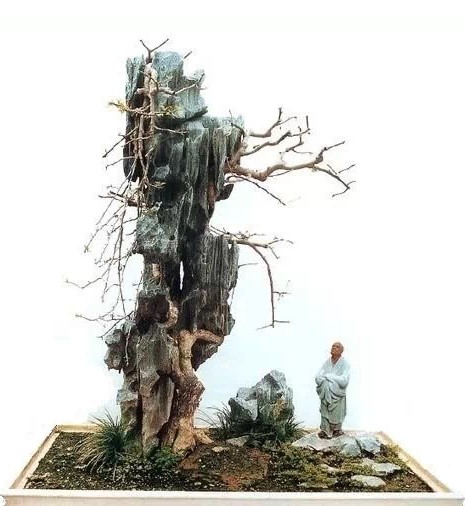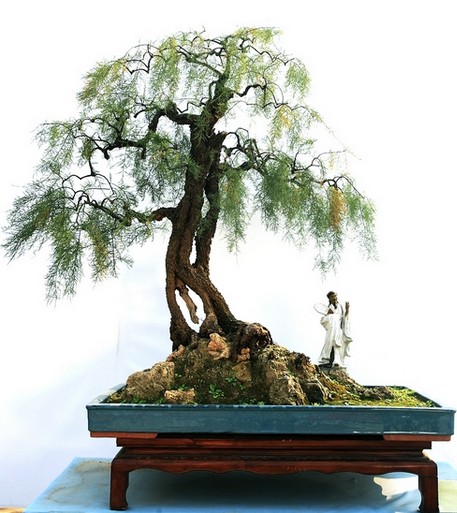Sharing of experience in making stone bonsai
Holding stone bonsai is composed of rough roots, sandwiched with rocks, and necessary election to embellish some bonsai accessories. It has the potential to stand erect on the peak, giving people the feeling of perseverance, continuous progress and endless life. Now I dedicate some practical experience in the process of making boulder bonsai to the majority of bonsai lovers for reference only.
First of all, we should pay attention to the selection of materials and roots; choose good growth, robust, fibrous root height, lateral roots had better have 5-6 rented long root stumps. The choice of rocks: choose hard texture, wrinkles on the surface, roots can be embedded in the natural grooves of rocks, such as Huaanshi (also known as Jiulong Wall right). The choice of bonsai: choose a shallow bonsai.
Secondly, the cultivation process. Before cultivation, all the basin surfaces should be trimmed and smooth to facilitate wound healing in the future. The roots of the selected stumps are sandwiched to the rocks, and the roots are straightened out one by one along the view of the rocks, which can be properly crossed naturally, and the roots and rocks are tightly tied together with thin wire or rope, and the shallow bonsai basin is selected. when filling the soil, we should pay attention to good drainage. Put the boulder stump into the appropriate position in the basin. If the rock is high, the bottom of the stone and the bottom of the basin are specially cemented to prevent the rock from being dumped, then fill in the finer sand until the basin surface can no longer be added, and then use a thicker plastic sheet to raise it from the basin surface to the end of the pile, and the soil is also filled to the end of the pile. The soil had better use pond mud and sand at 3:2. Make the soil as firm as possible, so that the soil is closely combined with the root of the stump, which is beneficial to the growth of the root.
After watering the pot at one time, observe that the soil is slightly dry and then watered, the evaporation and water demand of the newly planted stump itself is not big, the pot is covered with bricks to help irrigate the excess water, and it is also conducive to breathing. the basin should be placed in a cool place without direct sunlight. Water the trunk once in the morning and evening to ensure the water supply of the trunk, create a good growth environment for the sprouts, and slowly accept the sun to adapt to it for a period of time. The place where the sun is filled can be maintained normally. Watering must be in accordance with the principle of "see dry and wet". The stone pile scene that has just been put into the basin should not be fertilized, because the root wound of the pile scene is not finished and healed, and the concentration of fertilizer is not easy to control. It may cause the stump to burn and rot, causing all previous efforts to be wasted. After careful maintenance of the stump, it can be carefully trimmed, reshaped and tied into various forms of boulder bonsai according to the shape of the tree.
Finally, you can remove the elevated plastic sheet from the basin and wash the soil off the stone with tap water, so that the thick roots are exposed and a beautiful boulder bonsai is first made, and then you will experience the joy of success.
Time: 2019-06-04 Click:
- Prev

The artistic requirements of stone-attached bonsai are higher, and the smell of the mountains is strong.
Stone-attached bonsai, also known as tree-stone bonsai, is a bonsai form that skillfully combines trees with mountains and rocks. it is characterized by trees planted on mountains and rocks, roots or rooted in stone caves or crevices, or holding stones, and its style is elegant and elegant, or vigorous, or simple and vigorous, or steep, or open and spectacular.
- Next

Production and Collection of Tamarix trunks with Stone Bonsai
The production of Tamarix trunks with stone bonsai is basically the same as that of other trunk bonsai. Tang Qingan, master of bonsai art in Zhongzhou and provincial bonsai art master, said that attention should be paid to stone selection, basin selection, seedling selection, modeling and so on in the production of Tamarix trunks with stone bonsai. In the selection of stones, we should choose those stones that are hard.
Related
- Fuxing push coffee new agricultural production and marketing class: lack of small-scale processing plants
- Jujube rice field leisure farm deep ploughing Yilan for five years to create a space for organic food and play
- Nongyu Farm-A trial of organic papaya for brave women with advanced technology
- Four points for attention in the prevention and control of diseases and insect pests of edible fungi
- How to add nutrient solution to Edible Fungi
- Is there any good way to control edible fungus mites?
- Open Inoculation Technology of Edible Fungi
- Is there any clever way to use fertilizer for edible fungus in winter?
- What agents are used to kill the pathogens of edible fungi in the mushroom shed?
- Rapid drying of Edible Fungi

